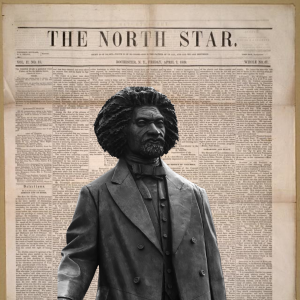#StorytellingSaturdays Aunt Lindy: A Story Founded on Real Life
5 min read
By Victoria Earle Matthews
Originally published in 1893.
Introduction
Victoria Earle Matthews was a pioneering African American author, journalist, and social worker. Her works often shed light on the experiences and resilience of Black women in post-Civil War America. “Aunt Lindy: A Story Founded on Real Life” is a poignant narrative that showcases Matthews’ commitment to highlighting the strength and compassion within African American communities.
Aunt Lindy: A Story Founded on Real Life
In the annals of Fort Valley, Georgia, few events will last longer in the minds of her slow, easy-going dwellers than the memory of a great conflagration that left more than half the town a complete waste. ‘Twas generally conceded to be the most disastrous fire that even her oldest residents had ever witnessed. It was caused, as far as could be ascertained, by someone who, while passing through the sampling room of the Cotton Exchange, had thoughtlessly tossed aside a burning match; this, embedding itself in the soft fleecy cotton, burned its way silently, without smoke, through the heart of a great bale to the flooring beneath, before it was discovered.
Although the watchman made his regular rounds an hour or so after the building closed for the night, yet he saw nothing to indicate the treacherous flame which was then, like a serpent, stealing its way through the soft snowy cotton. But now a red glare, a terrified cry of “Fire! Fire!” echoing on the still night air, had aroused the unconscious sleepers, and summoned quickly, strong, brave-hearted men from every direction, who, as though with one accord, fell to fighting the fire-fiend (modern invention was unknown in this quiet town). But the flames spread with such rapidity that all efforts to stay their progress were futile, and soon the Exchange, the bank, the post-office, and many other buildings were a mass of ruins.
The morning sun arose upon a scene of desolation and woe. The streets were filled with homeless, destitute people, and the air was rent with cries of distress. The mayor called a meeting of the citizens to devise means for the relief of the sufferers, and nobly did the people respond to the call. Among the many who came forward with offers of assistance was Dr. Bronson, the leading physician of the town.
“Gentlemen,” said he, “I have a large house, and it is at the service of the homeless. Let as many as can find shelter there come at once.”
His offer was accepted, and soon his house was filled to overflowing. But still there were others needing shelter, and among them a poor woman with a sick child. Dr. Bronson’s house was already crowded, and his wife and children were taxed to their utmost in caring for the sufferers. In this emergency, the doctor thought of Aunt Lindy, a colored woman living on the outskirts of the town, who was noted for her kindness and skill in nursing the sick.
Hastily mounting his horse, he rode to her humble cabin. Seeing a man weeding a small garden plot, he called, without alighting, “Hi there, Joel: where’s Aunt Lindy?”
“Right dar, in de cabin, doctor; jes wait a minnit,” as he disappeared through the doorway.
“Good day, Aunt Lindy,” as a tall, ancient-looking negro dame hurried from the cabin to the gate. Well accustomed was she to these sudden calls of Dr. Bronson, for her fame as a nurse was known far beyond the limits of Fort Valley.
“Mawning, doctor; Miss Martha and de chil’en was not teched by de fi’er?” she inquired anxiously.
“Oh, no; the fire was not our way. Lindy, I have a bad case, and nowhere to take him. Mrs. Bronson has her hands full of distressed, suffering children. No one to nurse him, so I want to bring him here—a victim of the great fire.”
“De Lawd, doctor, yo kin, yo kno’ yo kin; de cabin is pore, but Joel ner me ain’t heathins; fetch him right along, my han’s ain’t afeered of wuk when trubble comes.”
“I knew it, Lindy; I knew I could depend on you. I will bring him at once.”
Half an hour later, the doctor drove up to the cabin with his patient—a young man apparently about twenty-five years of age, whose pale face and bandaged head told of suffering and sorrow. Tenderly they lifted him, and bore him from the cottage resounding with childish prattle and glee, to the quiet, cleanly cabin of the lonely couple, Lindy and Joel, who years before had seen babes torn from their breasts and sold—powerless to utter a word of protest—to the highest bidder.
Days passed, and the young man hovered between life and death. Aunt Lindy’s skill and care were unremitting, and at length they were rewarded by seeing the light of reason return to the dark eyes of the sufferer.
“Where am I?” he faintly asked, as Aunt Lindy bent over him to offer a cooling drink.
“Yo’s wid frien’s, honey; jes drink dis, and don’t talk now; yo’s too weak.”
*He obeyed, and soon fell into a refreshing sleep. From that time his recovery

Victoria Earle Matthews was a groundbreaking African American journalist, author, and activist, born in 1861 to formerly enslaved parents in Georgia. Though she was Black, her light complexion allowed her to pass as white, a reality that informed her nuanced understanding of race and identity in America. Matthews was deeply involved in racial uplift movements and worked tirelessly to support Black women and children.
A prominent member of the Black Women’s Club Movement, Matthews founded the White Rose Mission, a settlement house in New York City that provided critical support to young Black women migrating from the South, helping them find jobs, safe housing, and community. Her work emphasized education, self-sufficiency, and racial pride.
Matthews’ literary contributions, including her 1899 short story “Aunt Lindy: A Story Founded on Real Life,” reflected themes of resilience, community, and the struggles faced by African Americans. Though she is not as widely recognized today as some of her contemporaries, such as Pauline E. Hopkins or Frances Ellen Watkins Harper, Matthews was a significant voice in 19th-century Black literature and activism, leaving a lasting legacy of empowerment and advocacy.
Want to see your short story featured in our pages or on our website? Click HERE to read our submission guidelines!







